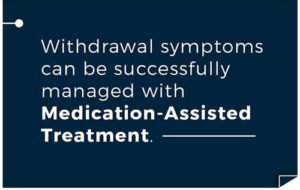- May 10
- AddictionDrug Addiction TreatmentTreatment
Despite the harmful and long-lasting effects of drug use, people struggling with drug addiction have a compulsive and uncontrollable urge to keep using. Stopping can be difficult. In fact, it may even seem impossible, especially because drug withdrawal symptoms can be extremely unpleasant, dangerous, and even lethal. However, with the right drug withdrawal treatment, people can overcome withdrawal and end their drug use.
If you or a loved one is suffering from a drug use disorder, Gateway can provide a safe place to manage the effects of drug withdrawal and help you take the first steps on the road to recovery. Personalized addiction treatment programs are available to help individuals live a drug-free life.
What Determines Drug Withdrawal Symptoms?
A drug use disorder affects a person’s brain and behavior. It often leads to the inability to control the use of the substance. Continued use interferes with the brain’s motivation and reward center, leading the user to crave and depend on the drug. When the drug is abruptly stopped, withdrawal symptoms will start.
Drug withdrawal symptoms can vary greatly and depend on several factors. These factors include:
- The type of drug
- Length of time the substance has been used
- Method of using (ingesting, injecting, or smoking)
- Dosage size
- Family history
- Other medical or mental health factors.
Drug Withdrawal Symptoms Vary Based on the Substance
- Alcohol: Alcohol withdrawal can be very dangerous and may include sweating, rapid heartbeat, hand tremors, insomnia, nausea and vomiting, hallucinations, restlessness, agitation, anxiety, life-threatening seizures, and delirium tremens (DTs).
- Benzodiazepines (also called “benzos”), including Xanax, Valium, and Ativan: Like alcohol, withdrawal symptoms from benzos can be physically harmful. They include heightened anxiety, increased blood pressure, rapid heart rate, delirium, hallucinations, and life-threatening seizures.
- Prescription opiates, including Vicodin, OxyContin, methadone, and morphine: Withdrawal symptoms are unpleasant but not usually life-threating. They can include sweating, chills, nausea and vomiting, sleeplessness, runny nose, and muscle cramps.
- Heroin: Withdrawal symptoms are similar to those of prescription opiates and often mimic the flu. Heroin withdrawal is not usually life-threatening.
- Stimulant drugs including cocaine, methamphetamines, and Ritalin: Physical symptoms of stimulant withdrawal are not life-threatening and can include sleepiness, moodiness, and hunger. Emotional withdrawal can cause depression, putting the patient at high risk of suicide and self-harm.
How Long Do Drug Withdrawal Symptoms Last?
The severity and length of withdrawal symptoms vary. They can depend on how long the person has been using and how long the drug remains in the system. Most acute withdrawal symptoms end after about two weeks. The withdrawal timelines for the most commonly misused drugs are as follows:
- Alcohol: Mild alcohol withdrawal symptoms begin within eight hours of the last drink. Severe symptoms peak within 24-72 hours. All symptoms typically begin to taper off after five to seven days, but they may continue for weeks.
- Benzos, including Xanax, Valium, and Ativan: Symptoms begin one to four days after the last dose, peak within two weeks, and then start to subside.
- Prescription opiates, including Vicodin, OxyContin, and morphine: Withdrawal begins eight to 12 hours after the last dose, peaks within 12-48 hours, and tapers off after five to 10 days.
- Methadone: Withdrawal symptoms can start within 24-48 hours and can last for two to four weeks.
- Heroin: Withdrawal begins six to 12 hours after the last dose, peaks within one to three days, and subsides after about a week.
- Cocaine: The first symptoms of cocaine withdrawal can be felt as soon as 90 minutes after the last dose and can last for seven to 10 days.
- Stimulant drugs, including methamphetamines: Symptoms can start between a few hours to a few days after the last dose and can last from one to four weeks.
Post-Acute Withdrawal Syndrome (PAWS)
People who consume large amounts of a drug—especially opioids—for long periods of time are at risk for longer-lasting drug withdrawal symptoms. Experts identify this as Post-Acute Withdrawal Syndrome (PAWS). According to Psychology Today, PAWS results from “significant changes to brain anatomy and chemistry.” It can occur even after the substance is no longer in a person’s system. Symptoms can include memory problems, sleep disturbances, sensitivity to stress, and emotional problems. They can come in waves, vary in intensity and duration, and often persist between six and 24 months.
What is the Most Effective Drug Withdrawal Treatment?
While drug withdrawal symptoms can be painful and scary, Medication-Assisted Treatment can be an effective drug withdrawal treatment solution. Gateway offers MAT as part of our numerous substance abuse treatment programs in Illinois to help manage symptoms and cravings in a professional environment. For more, contact Gateway now at 877.505.4673.




